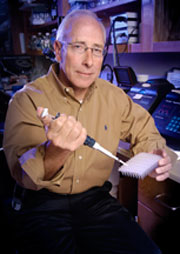Model Behavior
 |
After creating the first practical animal model for sickle cell disease, Tim Townes's team used it to test an experimental technique that could reframe the debate over stem cell research. |
Great research, like great art, often depends on finding the right model. In 1997, UAB’s Tim Townes, Ph.D., and Thomas Ryan, Ph.D., created the first practical animal model of sickle cell disease, a hereditary blood disorder. Ten years later, Townes, chair of the UAB Department of Biochemistry and Molecular Genetics, was involved in another first—with his own animal models as the crucial testing ground. In 2007, teams from UAB and the Massachusetts Institute of Technology reported the first successful treatment of sickle cell anemia in experimental animals using induced pluripotent stem (iPS) cells. The new stem cell technique uses normal skin cells, not the controversial embryonic stem cells.
This first “proof of principle” of the new technique promises to reframe both scientific and moral issues in the debate over embryonic stem cells. And Townes believes the transgenic mouse model developed at UAB holds promise for simulating and treating other diseases as well.
Read more breakthrough stories in UAB Magazine